|
In the world of fitness there are many standards when it comes
to ab training. In bodybuilding having a six pack and strong abs is a standard. In figure it may not be a standard but
it is a plus. In fitness it just may be a byproduct of being in really good shape. As far as powerlifting goes however, trying
to tell a powerlifter they need to do direct work their abs is like trying to tell a bodybuilder glute work is beneficial
to their training. The answer is true and beneficial in both cases, it’s convincing the athlete to do the work
sometimes is the problem. If your reading this to find out how to get a great six pack, this is not the article for you. The
focus today is all about working your abs for strength and power.
Direct Ab Work vs. Not Doing Direct Ab Work-
There is a constant debate that looms in the fitness circles. Do people really need direct ab work or not?
Half of the “experts” you ask will say absolutely yes. The other half will give you a resounding no. The answer
actually falls right down the middle. The answer falls right down the middle because for half of us the answer is yes and
the other half is no. It really is dependant on what your trying to achieve fitness wise. Does every person need to hit specific
training for their abdominal muscles. The answer tp that question is a definite no. If you just want to look good with toned
abs. Then a good training program with a good diet should do the trick. However if your doing a lot of heavy lifting, multi-joint
movements, powerlifting,or athletic movements that involve strong core and trunk support then yes you should. Power atheletes
do tones for their posterior chain but often neglect their anterior chain.
Six Pack vs. Strong Abs (making the distinction-)
First before we go any further lets make one distinction. A very nice six or eight pack does not necessarily
mean you have really strong abdominal muscles. Powerlifters are prime examples of this. A lot of times you would be hard pressed
visually to see a powerlifters abs but they have some of the strongest abdominal muscles around. What a very nice looking
six pack mostly equates to is a good diet and lean muscle. Strong ab muscles may not always look like a six pack but
strong abs make you more functional in heavy training and athletic activities.
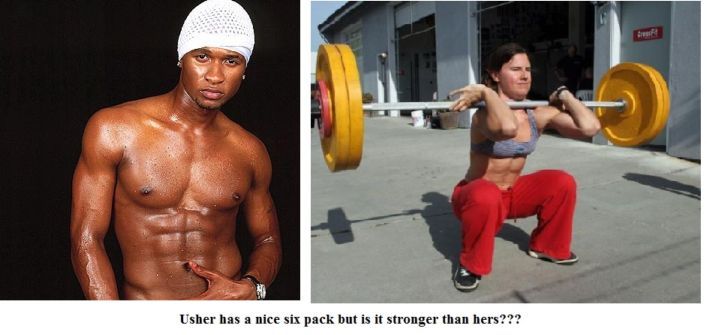
Why are strong abs important?
Strong abs are critical for strength and power. The muscles of the abdominals hold up the torso. When the
abdominals are developed to be really strong, they create a sort of natural weightlifting belt. This is crucial in exercises
like squats, front squats, good mornings and types of deadlifts. If your torso can not remain upright due to weak abdominal
muscles on exercises like squats you will lean forward too much and overstress your lower back. The stronger your abs are,
the more stable you are under or pulling heavy loads. Another benefit to ab training is to keep your core in balance. In powerlifting
you developing really strong lower back and butt muscles is sort of a standard. If you don’t keep your abs strong
to go along with a strong lower back and butt, it’s like having a steel plate holding up your posterior and a marshmallow
holding up your anterior. On exercises like front squats that use more abs than lower back, think how well that marshmallow
is going to hold up trying to brace a lot of weight. Another benefit of strong abs is it helps distribute the load of weight.
When your abs are not in balance with the other muscles in your core, they take on some of the load your ab muscles should
help hold.
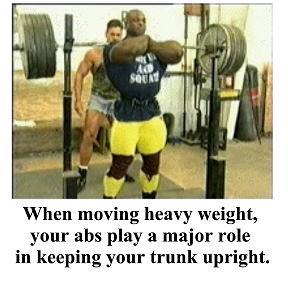
Understanding how to train for power-
One of the main mistakes people make with ab training is how they train their abs. Since we are focusing
on building strong abs, lets look at how to build abs for power. Here are a few simple rules when training abs for power and
strength
- Do not do lots of reps to build strong
abs-
- Lots of reps for you abs does not
do a lot for building massively strong abs. Lots of reps will build tons of muscle endurance but only moderate amounts of
ab strength.
- Do not use bodyweight exercises when
trying to build abs for power-
- Regular bodyweight ab exercises like
situps, do more for muscle endurance than strength. If you want to build strong abs put some weight in your movements.
- Keep your rep range in the 6-10 range-
- Just like you would train other muscles
heavy in the 6-10 rep range do the same for abs.
- Focus on all parts of your abs-
- When training to build strength and
stability in your abs don’t focus only on only your upper abs. Most crunchimg exercises focus mostly on the upper abs.
Be sure to specifically target the upper, lower, and obliques.
- Developing muscle endurance is also
important when trying to develop abdominal power-
sure we want to develop strength in our abs by using heavier weights and
heavier loads but working on muscle endurance is also important. The long a muscle can sustain tension under heavier loads
the stronger it will become in the long run.
- When training to build abdominal
strength focus 1-2 days on heavy work and 1-2 days on building muscle endurance-
On strength days you want focus on lifting heavy and building strength. Do this by using heavier weights
with a smaller rep range. Conversely you should also have an endurance day or two where you focus on building the endurance
in your abdominal muscles. You should still use weight with theses exercises but you want to use lighter weights and a higher
rep range, anywhere from 15-20 reps per set.
Power Exercises for Abs-
Now that we have some basic information on power ab training, let’s look at a few choice exercises
to build strong abs. The chosen exercises are ones that are more useful in power and athletic activities. Unlike traditional
sit ups where the movement is done off of your back, these movements move the practitioner thru various planes of motion.
Here are a few choice power exercises:
Decline Barbell Sit Ups- 4 sets of 9
With a barbell (a weight you could use for 9-12 reps) held straight above your chest level as you lie on
a decline bench with your legs and feet locked in place, tighten your abs. Leading with your chin and keeping your arms locked
and core tensed, do a sit up until you're at a 90° angle. Once you're upright, with barbell still overhead and arms locked,
slowly descend back down with control, tightening your abs as you go.
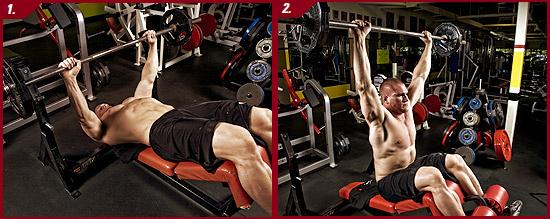
Standing Rope Crunches- 4 sets of 9
Attach a rope to a pulldown machine. Position the knee restraints of the machine at its top position. Facing
away from the machine, grasp the rope with both hands and pull it down around the neck so that your hands rest on your chest.
Next, flex the torso with a contraction of the abs, pulling down into the hips. Reverse this by extending the spine fully.
Barbell Ab Rollouts 4 sets 9
Kneel on an exercise mat with your shoulders directly over a barbell loaded with 10 lb. plates. Use an
overhand, shoulder-width grip. Roll the bar out in front of you, keeping your arms straight and your knees in place as your
hips, torso and arms go forward. Advance as far as you can without arching your back. Pause, then pull back to the starting
position
Suitcase Deadlifts 4 sets of 5
You can do these off the floor. If your having trouble you can set the pins in a squat rack or even by
using a smith machine set about knee level. Bend down like you are deadlifting and proceed to pick up the barbell like a suitcase.
Stay tight throughout the movement.
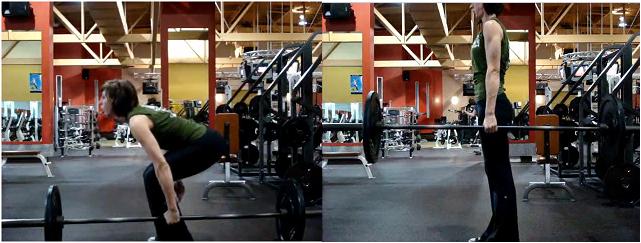
Front Squat Isometric Holds 3 sets of 5
Set yourself up in a squat rack for safety. Place the pins about sternum height. Grab the barbell like
you would a normal front squat. Make sure to keep your arms parallel to the floor or the barbell is going to go crashing down.
Squat down about five inches with a slight bend in your knees. Contract your abs tightly and hold the position for 10 -15
seconds. Once you have held the weight place it down and repeat.
Barbell Jackknives 3 sets of 12
Lay on your back with arm outstretched over head holding a light barbell. Simultaneously lift your legs
in the air along with your arms holding the barbell. Try to make the bar and your feet touch in the air. Descend back down
to starting position. Keep your core tight throughout the movement.
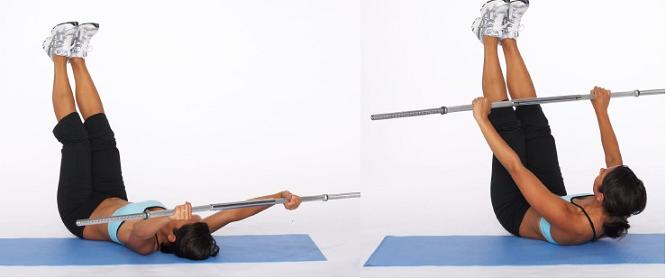
Training for endurance-
For endurance days
you can incorporate the same exercise but with lower weight and reps in the 15 to 20 rep range. Since we are still focused
on strength weighted ab exercises will still work better endurance wise than non weighted abdominal exercises.
Granted not everyone needs direct strength work for their core but it sure can benefit almost everyone.
If you’re a serious power athlete or just looking for a bit more athleticism adding strength to your anterior chain
is the way to go. A strong set of abs will provide powerlifters and athletes with the trunk support they need for explosive
burst, and heavy power movements. So next time your in the gym and feel you need a little extra strength maybe you should
focus on some ab strengthening work.
All articles on this site are authored or co-authored by Jarueba Taylor. They are the copy written
property of Taylored Nutrition.
|

